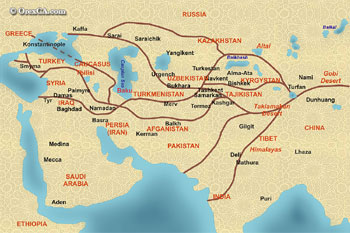
Moultonborough Academy, Moultonborough, New Hampshire
The Five Themes of Geography Meet the Himalayan Region
MOVEMENT Curriculum Standard: SS:GE:12:1.3 “Students will analyze spatial interactions and models of spatial organization, e.g., trade flows between countries... www.ed.state.nh.us/frameworks
The Silk Road is actually the Silk Roads, winding through central Asia to Europe. The domestication of the camel around 800 BCE boosted the movement of the traders considerably. The use of camels for pack animals rather than for riding enabled the caravans to traverse the deserts. The drivers usually traveled only one part of the route, selling their goods to the merchants who would journey along the next segment of the road. Each time the product changed hands, the price of it rose (each trader having to make their own profit.). There were three great eras of trade along the Silk Road. The first was under the Han dynasty of China. As the dynasty declined, so did the Silk Road. The second great era was under the Sui (586-618) and Tang (61-907) dynasties. Unfortunately, use of the road declined again after the early 12th century. The last great era of the Silk Road was under the Mongols. However, after the Mongols invaded the trade road cities, the Silk Road was never the same. By the 16th century, ships were traveling from Europe to Asia avoiding the intermediaries, bandits and weather that had slowed the caravans. Assignment: Locate your "Big Map" of the Himalayan Region and get into your groups. (The same groups in which you have been making your map.) You will trace the old Silk Route that the traders took to bring their products to Europe. You will also note, on your map, the products that flowed along the route. Decide on the icons that will represent each product and make a key so that everyone can enjoy your map. |
